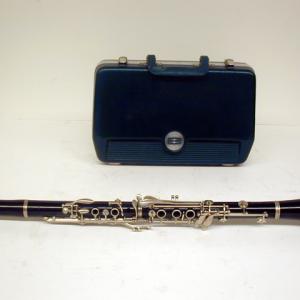College of Liberal Arts & Sciences
3D32.14 - Clarinet - Saxophone - Recorder - Tinwhistle
Assemble and demonstrate as needed.
Note that the Penzel-Mueller Clarinet set has A and B scale clarinets.
Sheet music is available for the Tinwhistles and Recorders. Note that the Tinwhistles are available in "C" and "D" scales.
- Thomas B. Greenslade Jr., "Whistling Tea Kettles, Train Whistles, and Organ Pipes", TPT, Vol. 54, #9, Dec. 2016, p. 519.
- Paul Hewitt, "Figuring Physics: Answer to October 2015 Figuring Physics Question", TPT, Vol. 53, #8, Nov. 2015, p. 499.
- Stephen Luzader, "PC and PVC Acoustics Demonstrations", TPT, Vol. 28, #7, Oct.1990, p. 459.
- Eli Metzger, "Musical Scales and Algebraic Groups", AJP, Vol. 35, #5, May 1967, p. 441.
- Richard J. Fitzgerald, "Pitch Sharpening in Woodwinds", Physics Today, Vol. 70, #2, Feb. 2017, p. 24.
- "Acoustics of Free-Reed Instruments", Physics Today, Vol. 64, #3, Mar. 2011, p. 44.
- "Saxophonists Tune Vocal Tracts", Physics Today, Vol. 61, #3, Mar. 2008, p. 19.
- George M. Hopkins, "Sound", Experimental Science, p. 123.
- A. D. Bulman, "A Galton Whistle and a Bamboo Pipe", Model-Making for Physics, p. 49.
- Stephen Stewart and William Strong, "Functional Model of a Simplified Clarinet", Musical Acoustics, p. 109.
- Arthur Benade, "On the Tone Color of Wind Instruments", Musical Acoustics, p. 17.
- Jearl Walker, "3.3, Whistles and Whistling", The Flying Circus of Physics Ed. 2, p. 147.
- Dr. Gordon Stables, R.N., C. Stansfeld Hicks, J. N. Maskelyne, Rev. Harry Jones, M.A, Dr. Stradling, Captain Crawley, Rev. A. n. Malan, M.A., F.G.S., and Many Others, "Chapter L. - The Penny Whistle, and How to Play It", The Boy's Own Book of Indoor Games and Recreations, A Popular Encyclopaedia for Boys, p. 425.
Disclaimer: These demonstrations are provided only for illustrative use by persons affiliated with The University of Iowa and only under the direction of a trained instructor or physicist. The University of Iowa is not responsible for demonstrations performed by those using their own equipment or who choose to use this reference material for their own purpose. The demonstrations included here are within the public domain and can be found in materials contained in libraries, bookstores, and through electronic sources. Performing all or any portion of any of these demonstrations, with or without revisions not depicted here entails inherent risks. These risks include, without limitation, bodily injury (and possibly death), including risks to health that may be temporary or permanent and that may exacerbate a pre-existing medical condition; and property loss or damage. Anyone performing any part of these demonstrations, even with revisions, knowingly and voluntarily assumes all risks associated with them.

